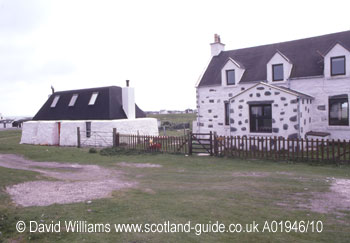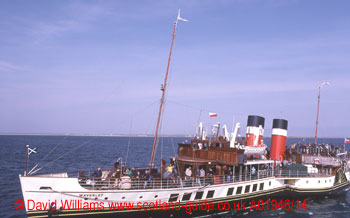 |
|
The
picture shows two neighbouring houses in Scarinish. On the left
is a modernised "black house", so called as the houses
became black inside from the peat smoke which burned on a central
fire. The drystane walls of these houses can be 3m (9 feet) thick.
The walls, which are rounded at the corners, originally supported
a thatched roof. The modernised houses are known as "white
houses" as they have had the walls cemented and whitewashed;
in addition, the roofs are covered with corrugated iron or felt
while inside there are now fireplaces with chimneys. |
 |
| The Waverley approaching the pier after a trip along Tiree`s southern coast. |
A winding road leads past the war memorial, skirts the island's collection of oil storage tanks, and then gradually rises to Scarinish, a collection of individual houses seemingly placed almost indiscriminately on the rolling grassy landscape. Most homes are only one storey high; at least one house has a thatched roof, while others have a felt roof which should be more able to withstand the high winds which the island "enjoys". Tiree, after all, is the country`s best windsurfing venue. Trees are conspicuously few in number and are only growing near the widely-spaced houses.
The sun makes another welcome appearance; however, most passengers reluctantly curtail their exploration and start to make their way back to the pier. Noisy lapwings and seagulls fly overhead while songbirds chirp from their perches on fences and buildings. It would be an idyllic and tranquil moment but for the fact that 450 other people have also invaded this otherwise-peaceful place.
Many passengers
scurry down to the end of the pier to get a good photograph of the ship
coming in after its short cruise. Their patience is rewarded and the sun
makes another appearance; the islandhas lived up to its sunny reputation.
The Tiree passengers disembark and the Oban- and Tobermory-bound passengers
ready themselves for the return voyage.
Once aboard, there is the usual searching for a seat. Many seek out seats high up in the upper decks, others look for more-sheltered spots; those in the know take into account the fact that on the return journey the previous-sheltered places may now become the exposed ones. Since eighty passengers have been on the Waverley for the past week, these are the hardy souls who are best-placed to know the most-favoured places to sit.
Before departing the island there is a round of applause for the Tiree pier staff - a Waverley tradition. Once clear of the pier and with the sun high in the sky and shining brightly, everyone settles down for a leisurely cruise homeward. We keep looking out for minke whales but the largest animals we see on this part of the journey are cormorants, sometimes a group of them flying together in close formation only a few centimetres avove the calm surface of the sea.
The Waverley
crew always take great pleasure in showing passengers many of the small
islands in the Inner Hebrides and so we head eastwards, towards
the Treshnish Islands. We first look at the Dutchman`s Cap
but since lots of people head to the starboard side to get a better view,
the purser has to make an announcement to ask some to go to the port side
so that we could get an even keel. A direct request relayed from the ship's
engineer as he wanted both paddles in the water ! Staffa (the site
of Fingal`s Cave) can be seen in the distance and we pass Lunga,
home to a great number of seabirds.
| Next page |
| First page of this article |